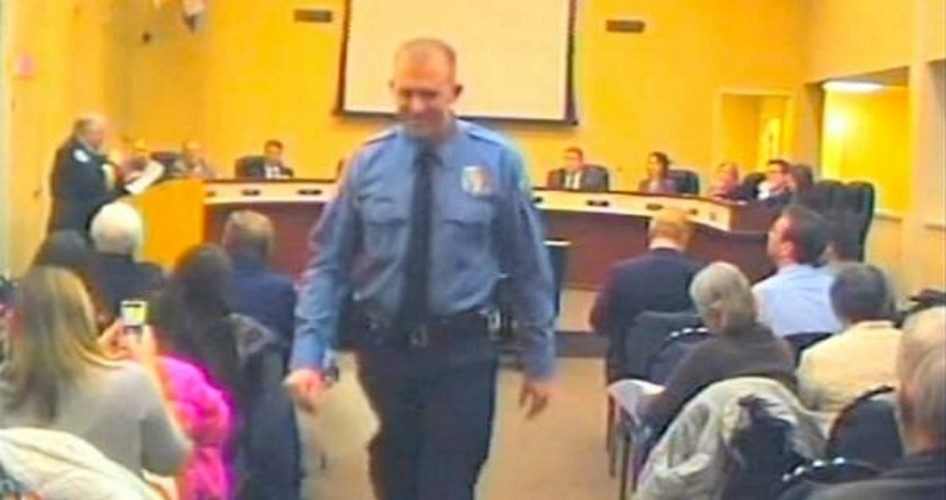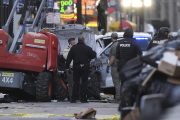
Recent reports in the New York Times and the St. Louis Post-Dispatch lend credence to police officer Darren Wilson’s version of events in the fatal August 9 shooting of Michael Brown in Ferguson, Missouri. Accusations that Officer Wilson (shown), who is white, had simply gunned down Brown, who is black, led to riots in the St. Louis suburb.
Last week the Times reported that forensic tests showed that Brown’s blood was on the officer’s gun, on the interior door panel of Wilson’s patrol vehicle, and on the police officer’s uniform.
This week the Post-Dispatch revealed that it had obtained a copy of the official autopsy report and the accompanying toxicology report prepared by the St. Louis County medical examiner. The autopsy showed that Brown had a close-range bullet wound to his hand, and the toxicology report found that Brown had marijuana in his system, the Post-Dispatch reported.
Dr. Michael Graham, the St. Louis medical examiner, reviewed the autopsy report for the Post-Dispatch. He told the newspaper that the autopsy “does support that there was a significant altercation at the car” and that it indicates that a bullet had entered Brown’s right thumb traveling toward his wrist. “The report on a supplemental microscopic exam of tissue from the thumb wound showed foreign matter ‘consistent with products that are discharged from the barrel of a firearm,'” the Post-Dispatch reported.
Dr. Judy Melinek, a forensic pathologist in San Francisco who also reviewed the autopsy report for the Post-Dispatch, said that it “supports the fact that this guy [Brown] is reaching for the gun, if he has gunpowder particulate material in the wound,” and that “if he has his hand near the gun when it goes off, he’s going for the officer’s gun.” Melinek also told the newspaper that the autopsy report does not support claims that Brown was shot while running away or with his hands up. As reported by the Post-Dispatch:
She [Melinek] said Brown was facing Wilson when Brown took a shot to the forehead, two shots to the chest and a shot to the upper right arm. The wound to the top of Brown’s head would indicate he was falling forward or in a lunging position toward the shooter; the shot was instantly fatal.
A sixth shot that hit the forearm traveled from the back of the arm to the inner arm, which means Brown’s palms could not have been facing Wilson, as some witnesses have said, Melinek said. That trajectory shows Brown probably was not taking a standard surrender position with arms above the shoulders and palms out when he was hit, she said.
But the official autopsy report made public this week by the Post-Dispatch and the forensic tests cited in last week’s New York Times article both lend credence to Officer Wilson’s version of events. Wilson, the Times reported, “has told investigators that he was pinned in his vehicle and in fear for his life as he struggled over his gun with Mr. Brown, according to government officials briefed on the federal civil rights investigation into the matter.” Wilson also reportedly told investigators that Brown had reached for his gun and had repeatedly punched and scratched him during the confrontation at the police car. At this time the gun was fired twice, hitting Brown in the hand once. The Times article noted that this physical struggle “speaks to Officer Wilson’s state of mind, his feeling of vulnerability and his sense of heightened alert when he killed Mr. Brown.”
On the other hand, Brown’s judgment at the time of the incident could have been impaired by the presence of THC, the active ingredient in marijuana, in his system.
A Brown family lawyer, Benjamin L. Crump, dismissed Wilson’s version of events. “The officer’s going to say whatever he’s going to say to justify killing an unarmed kid,” he told the Times.
A private autopsy was conducted on behalf of the family by Dr. Michael Baden, the same pathologist who testified for the defense in the O.J. Simpson murder trial. While this autopsy mostly comports with the official county autopsy (both agree on the number and location of the wounds), it appeared to Baden that no shots were fired at close range, with the muzzle of the gun being at least one or two feet away though it could have been 30 feet away. A third autopsy, ordered by the federal Department of Justice as part of its separate “civil rights” investigation, has still not been made public.
Many fear that should Wilson not be charged, riots could erupt again in Ferguson, perhaps dwarfing the protests that rocked the city following Brown’s killing. The Brown shooting raises controversial issues concerning the exercise of police powers. Many believe that the police unfairly target black Americans. Many believe that examples of police brutality are all too common, regardless of citizens’ skin color. And many believe that the job of the police officer is extremely difficult and dangerous, dealing with the most violent in our society on a regular basis. In that type of environment, the slightest error in judgment could cause the officer’s sudden death from a violent criminal.
For those of us who believe in the rule of law, the resolution of the case in Ferguson must not be influenced by the fear of riots. We can hope that the evidence in this case will determine the outcome, and that justice will emerge as the ultimate winner.
Photo of Officer Wilson: AP Images



